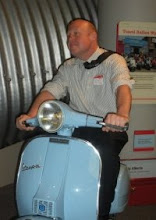

My first piece is on this wonderful cast iron hanger. It is amazingly ornate and I decided to sketch it out when my camera bateries started to die. The intracacies somehow remind me of tatoos. I wonder how a person decides to make that onate mold out of wood or plaster in order to pur that liquid iron into it and have it come out looking like it was produced from cloud or vapour. The shapes are fluid and natural and look more like the grew naturally than being fored to the point of liquidity and then let harden into the mold. I am unsure how to date this item, bit I am curious if these instricate sort of bulbous shapes are part of a "casting culture" the way skulls, dragons and mermaids are present in body art. I am not sure why, but I feel there is a real connection.
F 2.5o

Tin
This candle reflecter is a good example of the basic products being produced after the turn of the 19th century in America whan many of the 1st tin smiths began to operate. The large round backing for the candle would have reflected the light into the rest of the room. In fact, a good deal of candle is still melted into the receptacle fashinoned for it. You can tell from its alomost crisp, yet still hammered look that the larger pieces were rolled out and then hammered and snipped into wanted shapes.
The candle holder and various joinings on this item were connected with solder.
Tin is abundant in the collections and in the decoration at The Farmers' Museum. It's ease of manipulation and realtively quick turn around in terms of production time must have made it quite poular to use and produce.
The piece is clearly discolored from use and time. It may be from the 19th century, I would hope so if it is collections, but I have purchased similar items in the last five years that in ten years of use could look like this. There were many other tin items in the collection, cans, canisters and oddly shaped decorative pieces that had turend to rust. I am wondering why they were kept for so long and able to be saved?

Pwter? I hardly know her!
N004.1975
So this is an awesome looking item. It is marked with IPS and a date of 1824. This is one of the older items that I have worked with from the collections. It has a dull silver color but not the tarnished color of silver of mirrors. It feels as if the surface has some texture, and you can clearly see a good deal of scratches in it. It is not too heavy, and the pewter items I have at home tend to be large heavy candlesticks. I wondered if it was tin, but all the older tin items have long sense begun to rust. It looks llie it saw a good deal of use and I wondered if it may have been used in a tavern where it would see the kind of ware it seemed to show.

Tea Caddy N.143.73
This is a pewter pitcher taking a ride on an ornate silver tea cady. The cady isnot marked with any makers mark and is tarnished. There is a grape leaf motif and the bases are a porus wood that must have been used for liquid containers that tended to sweat. The wheels, the axels and all of this item is made of silver that must have been modled in these ornate shapes.
It has a wonderful shape. The mouth is irregular and the spout seems to be in estrange place. It looks almost organic rather than metal, like pottery or ceramic ratherthan metal. I don't know if this was always such a battered mess or just in the early design.
There are a other pewter items I have looked at including this next coffee urn that seems to have an iron base because my NYSHA badge stuck to it but the upper body was pewter or tin. Because it had many of the same qualities of the above item I think it is pewter. It lacked the real black dulling or rusting of tin. It had a big soldered fix it job on the side. You could tell it was a repair because it was on the messy side and the opposite side did not have the same work on the seam.'I wonder if the bottom is iron or steel based in order to conduct more heat, so it can be directly used to cook in?

N34.48


N67.60
At first glance seems to be a coffee pot that is a combination between silver with an iron interior.I think it may be silver plate or Britannia ware. The mark on the bottom indicates that it was Roger Smith and Co who specialized in a water pitcher. That would explain the write interior, and actually the rust.
It is dated June 13, 1869 My badge did not stick on the outside but did on the inside and you can clearly see the rust on the inside. there is a white glaze on the interior.






























